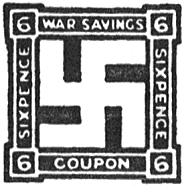 British Savings Coupons of World War I proudly
displayed the sign. The Warwick bicycle tyre and the insignia of Finland also sported the motif. The emblem has ancient
origins and is found in many cultures.
British Savings Coupons of World War I proudly
displayed the sign. The Warwick bicycle tyre and the insignia of Finland also sported the motif. The emblem has ancient
origins and is found in many cultures.
Ancient Mysteries no. 16, July 1980 (continuation of Journal of Geomancy)
From John Gaskell’s column “This Week”, Cambridge Evening News, 22 March 1980, page 5.
Reproduced as artwork in the original Ancient Mysteries.
{52}
WHEN Nigel Pennick exhibited a painting of a swastika at a Cambridge art exhibition in 1969 there were, understandably, some incredulous reactions.
Eleven years later Mr Pennick, a micro-biologist of Address, Bar Hill, is still going on about the symbol which for most of us represents the obscenity and terror of Nazi Germany. Now he has published a booklet “The Swastika” (Fenris-Wolf Publications 60p).
Just what kind of bizarre ghoul is this man, you may ask.
In fact Mr Pennick’s interest in the swastika stems from his own incredulity when he saw the sign 17 years ago on a laundry van in Dublin.
“I found that the laundry company had been established long before the Nazis adopted the emblem, probably using it as a lucky charm,” he says.
His curiosity led him to the information for his publication which puts “… the swastika in its proper perspective as a sign of vast antiquity … a truly universal symbol of mankind.”
Rudyard Kipling’s books carried the symbol until 1930,
 British Savings Coupons of World War I proudly
displayed the sign. The Warwick bicycle tyre and the insignia of Finland also sported the motif. The emblem has ancient
origins and is found in many cultures.
British Savings Coupons of World War I proudly
displayed the sign. The Warwick bicycle tyre and the insignia of Finland also sported the motif. The emblem has ancient
origins and is found in many cultures.
Swastikas in various forms can be found nearby in King’s College Chapel, Little Waltham Church in Essex and at Melbourn.
But Mr Pennick’s research has provoked some suspicion. Of King’s he says “They don’t actually say anything to you but an official will come along and wonder what you’re doing.”
He says: “The tainting of the swastika with the trappings of Naziism has rendered it suspect in the popular mind to the point where even to write about it is considered as some form of crypto-Nazi activity … it has now been virtually invalidated for use in any other context until well into the next century, in Europe at least.”
In different cultures it still has its uses. Mr Pennick says: “In the Indian elections recently the swastika was used instead of an ‘X’ to mark the ballot papers.”
One modern-day sinister application of the symbol is seen among Hell’s Angels, the motorbike fraternity. Their name is taken from an American air squadron whose members fought with dare-devil bravery alongside the French in World War I. The squadron had an Indian’s head as an emblem. The Indian’s headdress was fastened with a swastika button.
The swastika was originally used to bring good luck in battle. But it seems that today’s Hells Angels have misconstrued it as a badge of Nazi toughness. Today they often collect Nazi militaria as part and parcel of the image, wrongly assuming it to be symbolic of the original biking Angels.
As Mr Pennick points out: “A lot of the first Hell’s Angels in America in 1947 were ex-servicemen who fought against the Nazis. It’s hardly likely they would come back to use the enemy’s emblem.”
From “This Week”, Cambridge Evening News, 5 April 1980, page 5:
MY REPORT about the less bizarre applications of the swastika emblem caught the eye of Harold Darling, of Weston Colville, a collector of cigarette cards.
Mr Darling, for many years a Cambridge bus inspector, tells me that the swastika was used by the Euphrates Defences in action around the Persian Gulf from 1916 to 1918 – information gleaned from his collection.
As he points out: “It would seem that we used the swastika before Hitler.”